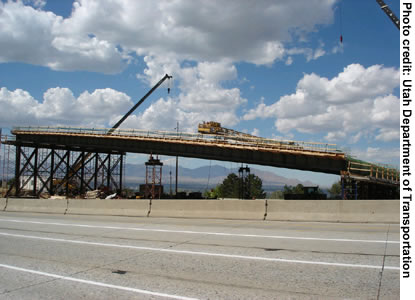U.S. Department of Transportation
Federal Highway Administration
1200 New Jersey Avenue, SE
Washington, DC 20590
202-366-4000
Focus
| Accelerating Infrastructure Innovations |
Publication Number: FHWA-HRT-09-014
Date: June 2009
Prefab just got easier. The Federal Highway Administration's (FHWA) new Connection Details for Prefabricated Bridge Elements and Systems manual (Pub. No. FHWA-IF-09-010) provides transportation agencies, contractors, and consultants with information on the state of the practice for accelerated bridge construction across the country. The manual features 150 connection details from a range of accelerated bridge construction projects.
"This is exactly what's needed for States, so that they can see what works and what is being done across the country," says Mary Lou Ralls of Ralls Newman LLC. "States can look at projects similar to what they would like to do and find the connection details. This will speed their design work."
The use of prefabricated bridge elements and systems, ranging from superstructures or substructures to totally prefabricated bridges, offers both faster and safer bridge construction and better quality. The prefabricated systems can be manufactured offsite at a prefabrication plant or adjacent to the project site by the contractor, under controlled conditions, and brought to the bridge location ready to install. Building in a controlled environment reduces weather-related delays and enhances constructibility, while also reducing traffic congestion and improving work zone safety. Accelerated bridge construction can also reduce life cycle costs and environmental impacts.
| "As the need to replace aging bridges grows in coming years, accelerated bridge construction is going to become even more important." |
While the manual provides some guidance on general accelerated construction techniques, it focuses on the details for connections of prefabricated bridge elements and systems. "When FHWA did a survey asking State transportation departments about the obstacles they faced in using prefabricated bridge systems, they said they did not have enough details about constructing prefabricated systems," notes Vasant Mistry of FHWA's Office of Bridge Technology. "Many people have been asking for a manual such as this. As the need to replace aging bridges grows in coming years, accelerated bridge construction is going to become even more important."
The manual is divided into four chapters, covering general topics, superstructures, substructures, and foundations. Superstructure topics include decks, beams, stringers, modular superstructure prefabricated systems, connections between superstructures and substructures, and miscellaneous superstructure details. The substructure chapter looks at piers, abutments, and wing walls, while the section on foundations covers footings and piles. The manual is organized so that bridge designers can pick and choose the details that will eventually make up the final bridge. In most cases, several options are presented for a particular connection. The details are presented on concise one-page data sheets, allowing designers to quickly build a "detail library" that is specific to the particular project.
 |
| The Utah Department of Transportation constructed the superstructure of its new 4500 South bridge in Salt Lake City offsite over a period of 4 months in 2007 |
For each connection detail included in the manual, contact information for the agency that provided the detail is listed, so that users of the manual can obtain more information if needed.
To obtain a free copy of Connection Details for Prefabricated Bridge Elements and Systems (Pub No. FHWA-IF-09-010), contact the FHWA Research, Development, and Technology Products Distribution Center, 814-239-1160 (email: Report.Center@dot.gov). The manual will be posted online in early July at www.fhwa.dot.gov/bridge. For more information about the manual, contact Vasant Mistry in FHWA's Office of Bridge Technology, 202-366-4599 (email: vasant.mistry@fhwa.dot.gov). Information on prefabricated bridge elements and systems is also available at www.fhwa.dot.gov/bridge/accelerated/index.cfm and on FHWA's Highways for LIFE Web site at www.fhwa.dot.gov/hfl.